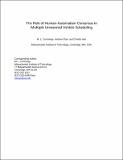| dc.contributor.author | Cummings, M.L. | |
| dc.contributor.author | Clare, A. | |
| dc.contributor.author | Hart, C. | |
| dc.date.accessioned | 2014-05-20T13:36:11Z | |
| dc.date.available | 2014-05-20T13:36:11Z | |
| dc.date.issued | 2010 | |
| dc.identifier.uri | http://hdl.handle.net/1721.1/87062 | |
| dc.description.abstract | Objective: This study examined the impact of increasing automation replanning rates on operator performance and workload when supervising a decentralized network of heterogeneous unmanned vehicles. Background: Futuristic unmanned vehicles systems will invert the operator-to-vehicle ratio so that one operator can control multiple dissimilar vehicles, connected
through a decentralized network. Significant human-automation collaboration will be needed due to automation brittleness, but such collaboration could cause high workload. Method: Three increasing levels of replanning were tested on an existing, multiple unmanned vehicle simulation environment that leverages decentralized algorithms for vehicle routing and task allocation, in
conjunction with human supervision. Results: Rapid replanning can cause high operator workload, ultimately resulting in poorer overall system performance. Poor performance was associated with a lack of operator consensus for when to accept the automation‟s suggested prompts for new plan consideration, as well as negative attitudes towards unmanned aerial
vehicles in general. Participants with video game experience tended to collaborate more with the automation, which resulted in better performance. Conclusion: In decentralized unmanned vehicle networks, operators who ignore the automation‟s requests for new plan consideration and impose rapid replans both increase their own workload and reduce the ability of the vehicle network to operate at its maximum capacity. Application: These findings have implications for personnel selection and training for futuristic systems involving human collaboration with decentralized algorithms embedded in networks of autonomous systems. | en_US |
| dc.description.sponsorship | This research was sponsored by Aurora Flight Sciences and the Office of Naval Research. | en_US |
| dc.language.iso | en_US | en_US |
| dc.publisher | The Role of Human-Automation Consensus in Multiple Unmanned Vehicle Scheduling | en_US |
| dc.subject | multiple unmanned vehicles | en_US |
| dc.subject | human supervisory control | en_US |
| dc.subject | workload | en_US |
| dc.subject | human-automation collaboration | en_US |
| dc.subject | scheduling | en_US |
| dc.subject | vehicle routing | en_US |
| dc.subject | trust | en_US |
| dc.subject | human-automation consensus | en_US |
| dc.subject | operator-to-vehicle ratio | en_US |
| dc.subject | decentralized network | en_US |
| dc.subject | automation brittleness | en_US |
| dc.subject | task allocation | en_US |
| dc.subject | unmanned aerial vehicles | en_US |
| dc.title | The Role of Human-Automation Consensus in Multiple Unmanned Vehicle Scheduling | en_US |
| dc.type | Article | en_US |
| dc.identifier.citation | Cummings, M. L., Clare, A. S., Hart, C. S. The Role of Human-Automation Consensus in Multiple Unmanned Vehicle Scheduling. Human Factors: The Journal of the Human Factors and Ergonomics, Vol. 52, No. 1, pp. 17-27, 2010. | en_US |
